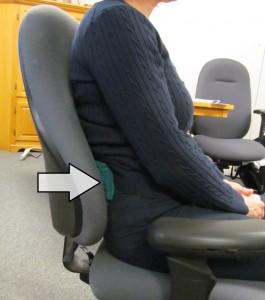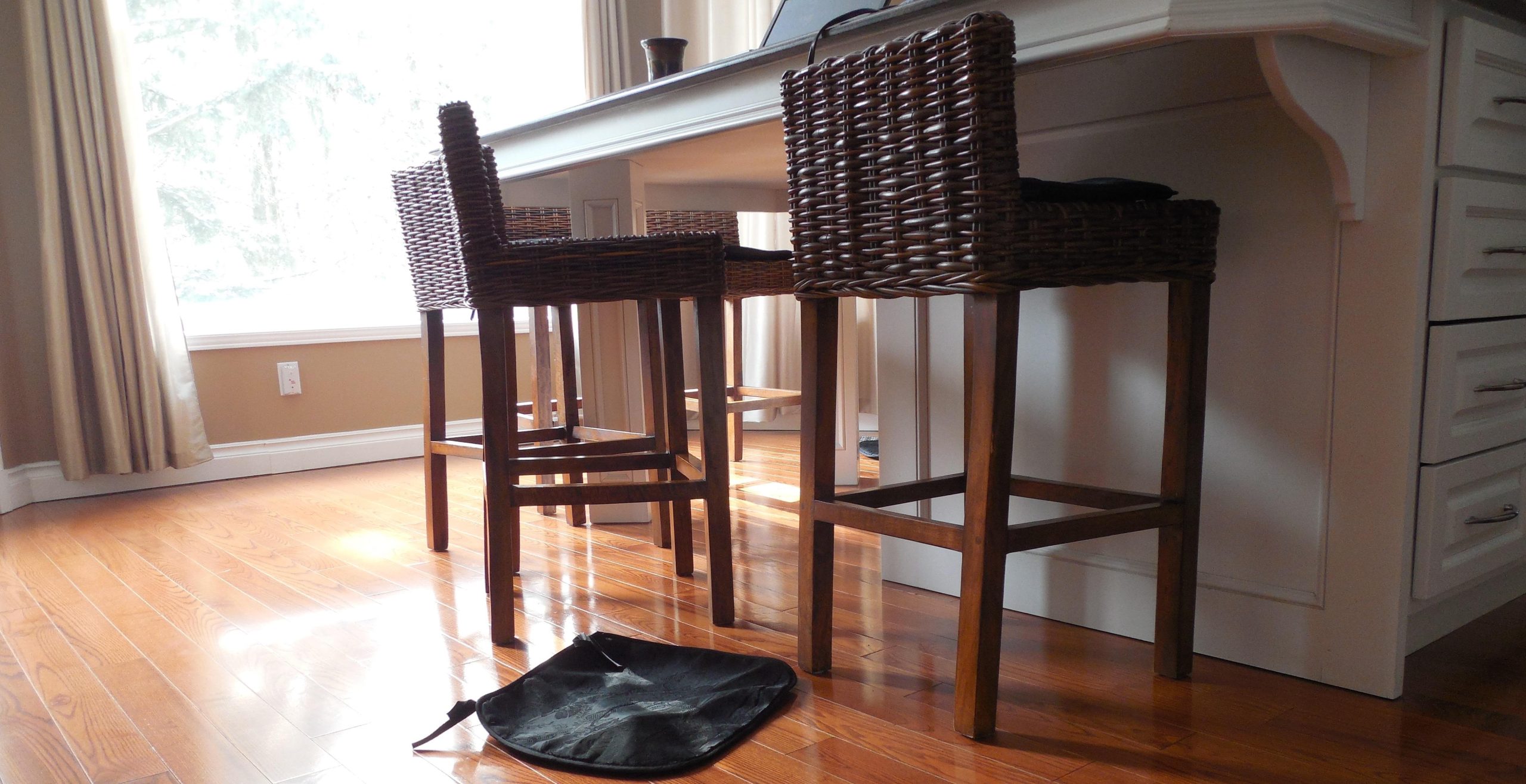At home, we recently decided that our kitchen chairs needed cushions. We don’t want to replace all seven chairs just yet, so we thought cushions would buy us a few more months. I knew that I wouldn’t be able to tie the cushions to the seat, because the design of the backrest doesn’t allow access to the chair’s leg. But I still figured that we’d be able to sit on the chair with the cushion in place. Like most quick-fix solutions, it’s not working out so well.
In much the same way, people often stuff a lumbar roll into the gap between the lower back and the backrest in their car or office chair. For a long car ride, this can really help….keeping the lumbar curve intact really helps reduce low back pain. In one of my old cars, I used to stuff a big mitten behind my back to boost support to my low back. But a “loose” lumbar roll isn’t always the best solution at work. Back to my kitchen….
In the week since I brought home the cushions, I have been stooping and scooping them off the floor constantly. When you sit on the chair, the cushion bunches up under you. Some people just yank it out and toss it, while others are more patient (or have bonier butts), and they hold the cushion while they sit, or re-position it after. But when you stand up, the cushion comes with you. Some of us pick up the cushion right away….others seem oblivious to the storm of cushions swirling on the floor.
In offices, if the lumbar roll is not secured to the chair, it will fall out. (In fact, they often slide down even if they are secured to the chair.) As I sit on my kitchen chair writing this, I think about how I’d like to go get another cup of coffee….but I don’t want to go through the hassle of positioning the cushion again. Here’s my main point (thanks for your patience)…the same thing happens in the office. If a person has to take time to get situated with cushions in place, and pull the chair up to the desk and maybe even adjust armrests, s/he will think twice about getting up and stretching or walking around. Employees often tell us that they sit for 2-4 hours at a stretch without getting up. And we absolutely know that movement is key to injury prevention. So what’s more important, encouraging movement, or supporting the low back? (Why can’t we do both?)
In offices, we’ve seen a surge in requests for lumbar cushions. It still shocks me, but some of the new, high end office chairs that are just coming out on the market have “optional” adjustable lumbar support. Some of them have lumbar supports that are so firm that they dig into your back. So people are coming to work armed with a variety of lumbar rolls. And the results have been mixed.
When we identify a need for a lumbar roll during an office assessment, we usually recommend that the employee should roll a hand towel lengthwise, or widthwise, in order to figure out what size cushion they need, before making a purchase. (If a hand towel isn’t big enough, try a larger towel, and so on.) If you can’t pin the roll to your chair, you can stuff it into the leg of some tights (colour and pattern choices are endless!), and tie the legs around the chair. (I might tie tights around my car seat if I have tinted windows, but I don’t really want tights strapped around my office chair.) If you want to purchase a lumbar roll that looks more professional, make sure that the size and density (squishiness) are right for you, AND that you will be able to secure it to your chair. Because, at the end of a long day, how often you stood up and stretched may be just as critical to your back as how well your lumbar spine was supported while you sat.
recommend that the employee should roll a hand towel lengthwise, or widthwise, in order to figure out what size cushion they need, before making a purchase. (If a hand towel isn’t big enough, try a larger towel, and so on.) If you can’t pin the roll to your chair, you can stuff it into the leg of some tights (colour and pattern choices are endless!), and tie the legs around the chair. (I might tie tights around my car seat if I have tinted windows, but I don’t really want tights strapped around my office chair.) If you want to purchase a lumbar roll that looks more professional, make sure that the size and density (squishiness) are right for you, AND that you will be able to secure it to your chair. Because, at the end of a long day, how often you stood up and stretched may be just as critical to your back as how well your lumbar spine was supported while you sat.


